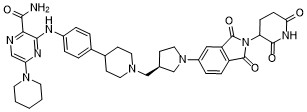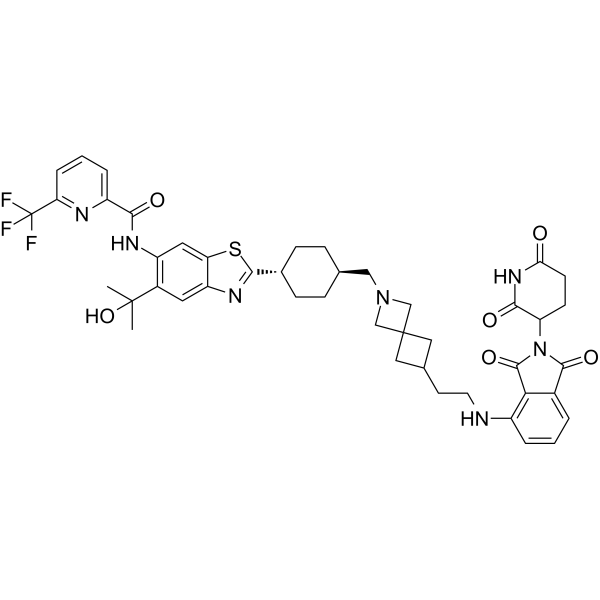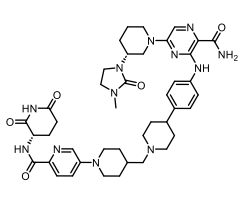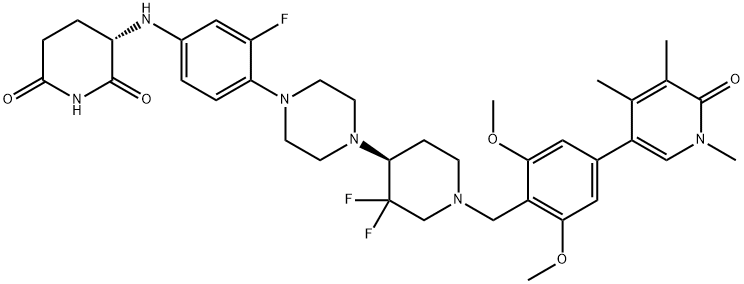 To enhance service speed and avoid tariff delays, we've opened a US warehouse. All US orders ship directly from our US facility.
To enhance service speed and avoid tariff delays, we've opened a US warehouse. All US orders ship directly from our US facility.
| Cat. No. | Product Name | Field of Application | Chemical Structure |
|---|---|---|---|
| DC70765 | SD-36 Featured |
SD-36 (STAT3 degrader SD-36) is a potent, selective STAT3 degrader (PROTAC), potently induces the degradation of STAT3 protein in vitro and in vivo.SD-36 is designed using an analogue of CRBN ligand lenalidomide and the STAT3 inhibitor SI-109, binds to recombinant STAT3 protein with Ki of 11 nM.SD-36 (250 nM) depleted >90% of STAT3 protein in MOLM-16 cells after 4 hr treatment and >50% of STAT3 protein in DEL, KI-JK and SU-DHL-1 cells after 7 hr treatment, also efficiently degraded STAT3 protein in murine cells.SD-36 displays extremely high cellular selectivity for degradation of STAT3 over other STATs.SD-36 effectively degrades both wild-type and mutated STAT3 proteins in cells, effectively degrades mutated STAT3 (D661Y, K658R mutant), also effectively degrades CRISPR-mutated homozygous Y705F mutant STAT3 protein in DLD-1/STAT3Y705F/Y705F cells.SD-36 displayed strong growth-inhibitory activities in a subset of leukemia and lymphoma cell lines (MOLM-16 cell line IC50, 35 nM), 100-fold more potent than SI-109.SD-36 (i.v. 25 mg/kg) effectively and selectively depletes STAT3 protein, achieves complete and long-lasting tumor regression in in mouse xenograft tumors.
More description
|

|
| DC65211 | KT-474 Featured |
KT-474 is a highly active and selective, orally bioavailable IRAK4 degrader being developed for the treatment of toll-like receptor (TLR)/interleukin-1 receptor (IL-1R)-driven immune-inflammatory diseases.
More description
|

|
| DC65324 | NX-2127 Featured |
NX-2127 is a potent, selective, and orally bioavailable BTK degrader with Kd of 18 nM (for WT BTK), 45 nM (BTK C481S), 18 nM (BTK T474I), 44 nM (BTK M437R), 97 nM (BTK V416L), and 88 nM (BTK L528W), respectively. NX-2127 efficiently engages the intracellular ubiquitin-proteasome system to simultaneously bind both BTK and the CRBN E3 ubiquitin ligase complex, inducing polyubiquitination and proteasome-dependent degradation of BTK, IKZF1, and IKZF3.
More description
|

|
| DC44798 | ARV-110 Featured |
ARV-110 is an orally active, specific androgen receptor (AR) PROTAC degrader. ARV-110 promotes ubiquitination and degradation of AR. ARV-110 can be used for the research of prostate cancer.
More description
|

|
| DC71669 | ARV471 Featured |
ARV471 is an orally bioavailable estrogen receptor-targeting (ER-targeting) PROTAC for the treatment of patients with locally advanced or metastatic ER+/HER2- breast cancer.
More description
|

|
| DC67462 | YJ1206 Featured |
YJ1206 is an orally bioavailable PROTAC compound that selectively degrades CDK12 and CDK13, demonstrating potent activity (IC50 = 12.55 nM) in VCaP cells. It induces DNA damage, triggers apoptosis, and drives tumor regression in treatment-resistant prostate cancer PDX models, highlighting its therapeutic potential.
More description
|

|
| DC41141 | endo-BCN-O-PNB Featured |
endo-BCN-O-PNB is an alkyl/ether-based PROTAC linker that can be used in the synthesis of PROTACs.
More description
|

|
| DC74494 | GNE-0011 Featured |
GNE-0011 is a monovalent, JQ1-based BRD4 degrader that is not linked to an E3 ligase binder, triggers proteasomal and ubiquitin-dependent selective degradation of BRD4 over BRD2 and BRD3.
More description
|

|
| DC60361 | DLin-K-DM4 |

|
|
| DC60470 | TCIP1 |
TCIP1 is the most potent transcriptional/epigenetic CIP (chemical inducers of proximity) and specifically activates BCL6 target genes. TCIP1 kills diffuse large B cell lymphoma cell lines, including chemotherapy-resistant, TP53-mutant lines and exhibits cell-specific and tissue-specific effects. TCIP1 successfully killed large B cell lymphoma cell lines, including chemotherapy-resistant TP53-mutant lines and exhibited cell-specific and tissue-specific effects. The activation of apoptosis to cell death took place in just 72 hours.BCL6 is critical to the lymphatic system, and mice engineered without the BCL6 gene die of complex inflammatory reactions. BRD4 is heavily involved in genome function and stability across many processes. Concerns regarding utilizing these important gene expressions and how they might affect off-target healthy tissues were addressed in the study.TCIP1 acts in a context-specific manner requiring the expression of BRD4 and BCL6 to both be present in order to bind them and operate at a concentration that would occupy only a tiny fraction of the total BCL6 molecules.TCIP1 induced dramatic transcriptomic changes in the spleen, notably with an upregulation of the FOXO3 gene, which mirrored activity in the targeted cancer cells. Despite the significant transcriptomic changes in the spleen, TCIP1 was well tolerated without adverse effects, with no significant differences in mouse body weight and no noticeable abnormalities such as inflammatory infiltrates or apoptotic cells.
BCL6-BRD4 TCIP1 (TCIP1) is a potent BCL6-BRD4 transcriptional/epigenetic chemical inducer of proximity (TCIP) by covalently linking BCL6 binder BI-3812 to BRD4 ligand JQ1, selectively kills DLBCL cells with EC50 of 1.3 nM against KARPAS422 cell.
TCIP1 rapidly and robustly killed other DLBCL lines with high levels of BCL6, but JQ1 and BI3812 separately or together shows100–1,000-fold less-effective cell killing.
TCIP1 is 200–10,000-fold more potent in killing DLBCL cells than the degradation of BRD4 by dBET1 and/or degradation of BCL6 by BI3802.
TCIP1 induces a stable, cooperative protein-protein interaction between bromodomain 1 (BD1) of BRD4 and the BTB domain of BCL6.
TCIP1 shows affinity for intracellular ternary complex of BRD4 with Kd of 340 nM in TR-FRET assays.
TCIP1 induces G1/S and G2/M block in the cell cycle, TCIP1 (10 nM) represses MYC and its targets while activating pro-apoptotic genes in KARPAS422 cells.
TCIP1 kills diffuse large B cell lymphoma cell lines, including chemotherapy-resistant, TP53-mutant lines, at EC50 of 1-10 nM in 72 h and exhibits cell-specific and tissue-specific effects, capturing the combinatorial specificity inherent to transcription.
More description
|

|
| DC44401 | DSPE-PEG14-COOH Featured |
DSPE-PEG14-COOH is a PEG-based PROTAC linker that can be used in the synthesis of PROTACs.
More description
|

|
| DC44304 | DSPE-PEG2-mal Featured |
DSPE-PEG2-mal is a PEG-based PROTAC linker that can be used in the synthesis of PROTACs.
More description
|

|
| DC45705 | Thalidomide-NH-PEG1-NH2 hydrochloride Featured |
Thalidomide-NH-PEG1-NH2 hydrochloride is a synthesized E3 ligase ligand-linker conjugate that incorporates the Thalidomide based cereblon ligand and a linker used in PROTAC technology.
More description
|

|
| DC74479 | BSJ-05-037 Featured |
BSJ-05-037 is a potent and selective heterobifunctional degrader of ITK with DC50 of 17.6-41.8 nM in TCL lines DERL-2 and Hut78.
More description
|

|
| DC72888 | Z0933M Featured |
Z0933M is a potent S phase kinase-associated protein 1 (Skp1) inhibitor with Kd of 54 nM, potently inhibits Skp1-F-box protein-protein interactions with Ki value of 231 nM in FP-based in vitro competition assays.
More description
|

|
| DC67098 | cis-AGB1 Featured |
Cis-AGB1 is a negative control for AGB1 . Exhibits no significant VHL binding affinity.
More description
|

|
| DC45201 | PROTAC BRD4 Degrader-13 Featured |
PROTAC BRD4 Degrader-13 (compound 9d) is a potent chimeric BRD4 degrader. PROTAC BRD4 Degrader-13 can be conjugated with STEAP1 and CLL1 antibodies to degrade the BRD4 protein in PC3 prostate cancer cells, with a DC50 of 0.025 nM and 6.0 nM, respectively.
More description
|

|
| DC74522 | WDR5 PROTAC MS40 Featured |
MS40 is a cereblon (CRBN)-based proteolysis targeting chimera (PROTAC) degrader of the onco-target WD repeat domain 5 (WDR5) [1]. WDR5 is an integral component of the MLL/KMT2A lysine methyltransferase protein complex. The WDR5-binding component of MS40 is the selective inhibitor OICR-9429, and the CRBN-targeting moiety is the immunomodulatory drug pomalidomide. MS40 promotes degradation of WDR5 and the pomalidomide transcription factor neo-substrates IKZF1 and IKZF3.
More description
|

|
| DC12249 | E3 ligase Ligand 1 dihydrochloride |
E3 ligase Ligand 1 dihydrochloride is a Hippel-Landau (VHL) E3 ligase-binding moiety based on PROTAC technology.
More description
|
|
| DC74523 | XY-07-35 Featured |
XY-07-35 is a potent, selective HDAC6 proteolysis targeting chimera (PROTAC) degrader with IC50 of 48.5 nM.
More description
|

|
| DC67029 | KT-413 Featured |
KT-413 (example I-3) is a potent IRAK degrader.
More description
|

|
| DC74301 | NX-1607 Featured |
NX-1607 (Compound 23) is an inhibitor of Cbl-b, an E3 enzyme in the ubiquitin-proteasome pathway, with an IC50 value of less than 1 nM. NX-1607 can be used in cancer research.
More description
|

|
| DC60530 | BTK-IN-24(NX-5948) Featured |
NX-5948,be also known as BTK-IN-24,is an oral BTK degrader.
More description
|

|
| DC65207 | CFT-8634 Featured |
CFT8634 is an oral activity degrader targeting BRD9 extracted from patent WO2021178920A1 compound 174. CFT8634 can be used for the research of synovial sarcoma and SMARCB1-deleted solid tumors.
More description
|

|
| DC65210 | CFT1946 Featured |
CFT1946 is an orally active and selective target ligand for BRAF kinase.
More description
|

|
| DCAPI1328 | Alprostadil(Caverject) Featured |
Alprostadil(Caverject) is a prostanoid receptor ligand, with Kis of 1.1 nM, 2.1 nM, 10 nM, 33 nM and 36 nM for mouse EP3, EP4, EP2, IP and EP1, respectively. Prostaglandin E1 induces vasodilation and inhibits platelet aggregation. Prostaglandin E1 can be used as a vasodilator for the research of peripheral vascular diseases.
More description
|

|
| DC42463 | Thalidomide-NH-CH2-COOH |
Thalidomide-NH-CH2-COOH is the Thalidomide-based cereblon ligand used in the recruitment of CRBN protein. Thalidomide-NH-CH2-COOH can be connected to the ligand for protein by a linker to form PROTACs, such as THAL-SNS-032.
More description
|

|
| DC31014 | GMB-475 Featured |
GMB-475 is a degrader of BCR-ABL1 tyrosine kinase based on PROTAC, overcoming BCR-ABL1-dependent drug resistance. GMB-475 targets BCR-ABL1 protein and recruits the E3 ligase Von Hippel Lindau (VHL), resulting in ubiquitination and subsequent degradation of the oncogenic fusion protein[1].
More description
|

|
| DC44905 | Vepdegestrant (ARV-471) Featured |
ARV-471 is a best-in-class, orally active estrogen receptor (ER) PROTAC degrader. ARV-471 is developed for the research of breast cancer.
More description
|

|
| DC40593 | Folate-PEG2-amine |
Folate-PEG2-amine is a PEG-based PROTAC linker that can be used in the synthesis of PROTACs.
More description
|

|